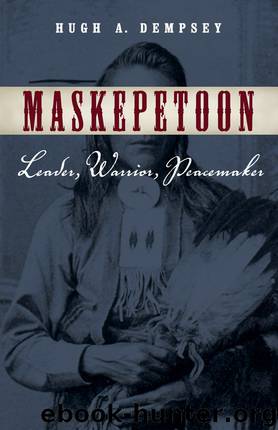Maskepetoon by Hugh A. Dempsey

Author:Hugh A. Dempsey
Language: eng
Format: epub
ISBN: 978-1-926936-58-1
Publisher: Heritage House
Published: 2011-01-01T05:00:00+00:00
Chapter Twelve
The Buffalo
Many Crees were turning away from their traditional trapping activities to become meat suppliers as part of a wider international trend. As buffalo became scarce at such places as Fort Pelly and Fort à la Corne on the eastern edge of the plains, traders had to rely more and more on places like Edmonton and Fort Pitt to supply the needs of the fur trade.
In fact, buffalo herds were decreasing all across America. There were an estimated 60 million buffalo at the time of Columbus’ landfall, and the figure had remained steady as long as they were hunted only by Indians seeking food and robes. But as Europeans arrived, the market for buffalo robes and meat increased steadily. By 1820, there were no more buffalo east of the Mississippi River, and a decade after that, the total population was estimated to have dropped to 40 million. The slaughter continued in order to meet the steady European and American demand. In 1840, the American Fur Company sent 67,000 robes down the Missouri River from the Blackfoot trade, and in 1848, some 110,000 robes were sent. There was also a demand for buffalo tallow and tongues. In 1848 alone, 25,000 buffalo tongues were exported from buffalo country. In many cases, the buffalo had been killed solely for their tongues. In the 1850s, about a quarter of a million buffalo were being slaughtered every year just for robes.
At the same time, the fur-trading companies required large amounts of dried meat and pemmican to supply their northern posts. Over a ton of fine pemmican was needed every year just to take care of Norway House and the lower forts. The Hudson’s Bay Company’s demands were clearly indicated in the minutes of the Northern Council in 1830:
That Gentlemen in charge of Districts & Posts be directed to use their utmost endeavors to collect large quantities of Leathers dressed, and Parchment, Buffalo robes, Pack Cords, Snow Shoe line, Sinews, tracking Shoes, Leather tents, &c., &c., as these are articles absolutely necessary for the trade in many parts of the Country and cannot be purchased in Europe or Canada.(1)
The buffalo usually were found just south of the North Saskatchewan River, but their movements were unpredictable. Prairie fires might keep them away, weather conditions could affect their movements, and sometimes they just seemed to have an ornery streak and failed to show up. In 1849, for example, a fur trader’s wife wrote that at Edmonton, “the Indians are starving in every direction & of course the dividends will be small. Even the Buffaloes have left the Saskatchewan & there will be no dried Meat nor pemican for next year.”(2)
With the overhunting, the quest of the Americans for robes, and the Crees supplying large amounts of meat and robes for the trade, the buffalo population was destined to recede from the edges of their grazing lands. As historian Arthur Ray commented about the needs of traders:
In order to obtain the supplies of dried buffalo meat, fat, and
Download
This site does not store any files on its server. We only index and link to content provided by other sites. Please contact the content providers to delete copyright contents if any and email us, we'll remove relevant links or contents immediately.
Waking Up in Heaven: A True Story of Brokenness, Heaven, and Life Again by McVea Crystal & Tresniowski Alex(37633)
Still Foolin’ ’Em by Billy Crystal(36228)
Cecilia; Or, Memoirs of an Heiress — Volume 1 by Fanny Burney(32396)
Cecilia; Or, Memoirs of an Heiress — Volume 3 by Fanny Burney(31775)
Cecilia; Or, Memoirs of an Heiress — Volume 2 by Fanny Burney(31744)
Fanny Burney by Claire Harman(26503)
Empire of the Sikhs by Patwant Singh(22922)
We're Going to Need More Wine by Gabrielle Union(18924)
Hans Sturm: A Soldier's Odyssey on the Eastern Front by Gordon Williamson(18448)
Plagued by Fire by Paul Hendrickson(17310)
Out of India by Michael Foss(16769)
All the Missing Girls by Megan Miranda(15442)
Cat's cradle by Kurt Vonnegut(15126)
Pimp by Iceberg Slim(14255)
Molly's Game by Molly Bloom(14039)
Bombshells: Glamour Girls of a Lifetime by Sullivan Steve(13941)
Leonardo da Vinci by Walter Isaacson(13128)
For the Love of Europe by Rick Steves(12439)
4 3 2 1: A Novel by Paul Auster(12245)
